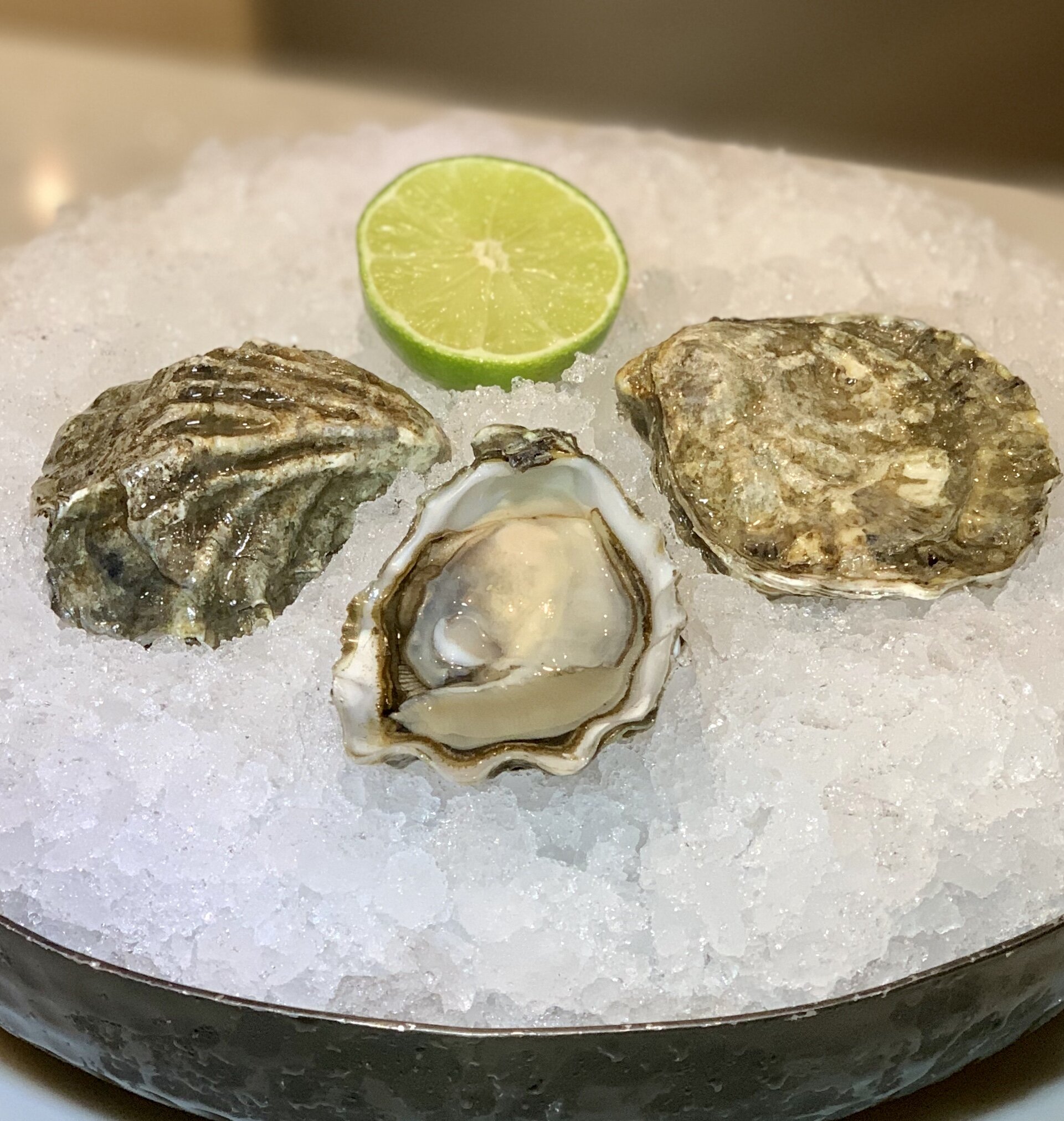While we DO NOT CURRENTLY PRODUCE OR DISTRIBUTE OYSTERS we hope to do so very soon. Meanwhile, we are often asked to RECOMMEND OYSTERS & GROWERS WE TRULY BELIEVE IN! And so we present this page for your edu-tainment!
WHAT OYSTERS DO WE LOVE THE MOST
Well, there are quite a few, actually. But the question cant really make sense or be answered intelligently no matter how you put it. Because, if you love oysters, you love many of them. Just like if you love wine, you have many wines you appreciate. We can say we have a few favorites but nobody that really knows oysters can really say “there’s just one”. Usually those that do came from the place they say has the best oysters. So, good for them, but its not a legitimate answer to the question because there ISN’T ONE!
OYSTERS 101
WHAT YOU MUST KNOW ABOUT OYSTERS
Start here to understand the FIVE SPECIES OF OYSTERS.
This is Oysters 101 that 99.9% of “oyster lovers” don’t even know. Once you understand this, you can dig into the “rest of the very tip of the iceberg” relative to what there is to know about oysters. Below we’ll help you do that and point out a few of our favorite oysters & oyster producing regions in the process. Anyway, congratulations. If you watch that video you are in the top 1% of “oyster aficionados” is the world.
“OLYMPIA”
(Ostrea Lurida) NATIVE PACIFIC
There are only a small handful of producers of this amazing oyster which was the favorite of both James Beard and Mark Twain. This is the only oyster native to the west coast of North America but over fishing, pollution and lost of habitat has pushed them to near extinction in the wild. These are small in size but HUGE in flavor. For the best sources for buying direct reach out directly to Chelsea Oyster Farms and Taylor Shellfish. Watch a video we made about SHUCKING THEM here and you’ll fall in love with these little gems. So so many good things to say about this, the least known (perhaps) oyster. Its not only a singular species, but, nearly a singular variety, meaning there’s really only one region in which they are grown, a tiny part of Puget Sound near Shelton, WA. The flavor is a ride…it twists and twirls, rises and cascades in just a few chews. So easy to shuck and so rewarding to eat. You almost never see them in restaurants because they are tiny (never larger than 1”) and expensive too. But not so much when you buy direct. They’re generally available from about Oct - Feb so mark your calendars. If we HAD to say which oyster was our very favorite we’d probably say Oly’s.
“KUMAMOTO”
(Crassostrea Sikamea) PACIFIC (Non-Native)
Kumos were introduced by Asian immigrants who became oyster growers in the Pacific US & Canada regions. These days there are only a small handful of places where Kumo’s come from and so we say there are 3 VARIETIES OF THIS SPECIES as there are 3 regions the same species is produced in. WA, CA & MX with some others grown on as small scale in OR. They’re also still grown where they are native and that is Kumamoto Bay, Japan. But we cannot import Japanese oysters to the US so we leave Japan off our list for now. We can buy Kumos from WA, CA and MX, however. And here’s all you need to know. The WA product is superior. Taylor Shellfish grows the best WA Kumos and theyll ship them direct to your house. That along is a $1,000 reason to learn to shuck because you can save that in the first 300 Kumos you shuck at home vs. consume in a restaurant. The WA product is the best and Taylor is probably the only commercially viable producer of them. Or, at least, theirs are probably the only ones you ever get your hands on outside of WA. CA grows some in Humboldt Bay, which is NOT the cleanest body of water (decades of pulp mill pollution). The water is bad enough that the state of CA requires shellfish harvesters there to put special tags on oysters from that water which basically say (these are like cigarettes - NOT GOOD FOR YOU). Our advise on these is DONT EAT, BUY OR SELL HUMBOLD BAY GROWN KUMOS. They suck anyway. Out of a bag of 60, 40 might open well and be presentable. Garbage! Hog Island Oyster Co also sells a Kumo and says it comes from Tomales Bay (Good Water). But on the page where they sell them they put the CA “Warning” we talked about above. The only other good Kumo is a Mexi-Moto or Baja-Moto. We prefer not to call them Kumo’s because they are not the equivalent to the WA product but they are rather good. Getting your hands on them is a task, however. If you are interested in them, let us know and we will help you.
“BELON “
(Ostrea Edulis) ATLANTIC (Non-Native)
AKA “European Flat”. Native to Belon River, France.
A very interesting and curious oyster. Common in Europe. Very rare in the US & Canada where very few are consumed. We get them in the US from Maine because, somehow, there are a stash of wild Belon up there. Our theory is that French Settlers or Explorers had brought some Belon along and they somehow wound up in the waters of ME. Divers catch as few as 5,000 a year for US Consumption. They’re more popular in Canada, especially Quebec. These are oysters you either love or hate. They are STRONG in flavor and that flavor is Nickle. VERY MINERAL finish on these. And astringent. The flavor and texture of the oyster can literally dry your mouth out. Some love this sensation others loathe it. They dont live long out of the water so rubber bands are used to keep them closed for shipping. This is not done for any other live oyster. And quite a few dont make it to the plate as they die in the shipping and storage product. They’re hard to shuck too. Perhaps this our least favorite oyster but we always have them on offer in the times of the year when all 5 species are available.
“VIRGINICA”
(Crassostrea Virginica) ATLANTIC & GULF (except for 2)
AKA “East Coast or Gulf” depending on which region they come from. For many Americans, this is the only oyster they’ve ever had. This species has MANY HUNDREDS OF VARIETIES as there are hundreds of regions / producers that these oysters come from. Some are wild caught but most are farmed. None are the exact same and variations of all kinds (size, shape, color, texture and flavor) are not just common but the norm. In fact, the same variety can taste quite different depending on the season or the tide in which it was harvested. Massive diversity in this species, for sure. Also, time to market varies depending on where they are growing. New Brunswick Canada is a hugely productive region but these oysters take 3-5 years to get to market size. On the contrary, wild Gulf oysters (like those from TX or LA) can mature from seed to market size in 6 months. This is due to the fact that far north oysters grow much slower because there is only food in the water (plankton & algae) for 3-5 months a year. In the Gulf of Mexico or South Carolina there is food in the water year round (and water temps stay relatively high) so these oysters never stop growing. The most important thing to know about a virginica is they are native to the East / Atlantic Coast of the US and The Gulf of Mexico. Some, like two (Taylor Shellfish and Hog Island Oysters) have been able to grow a virginica from seed to market size in WA & CA, respectively. Taylor’s are called Totten Inlet Virginica and if you can get you hands on them GET THEM! They are spectacular. Hog Island’s Virginica is not an oyster we’ve been able to get our hands on as of yet.
“GIGAS”
(Crassostrea Gigas) PACIFIC (Non-Native)
AKA West Coast. Native to ASIA, not North America. Introduced by Asian immigrants who became agriculturists. There are many ways in which they are grown but there are two major groups: Tumbles & Beach Grown. Tumbled methods round off the edges of the oysters as they grow. This produced a rounder shape, smoother shell and deeper cup. Some are tumbled more than others and the most common method for tumbling is to tie a buoy to a bag of oysters. Tide comes in, bag floats up, oysters fall down. Tide goes out, the opposite. They get tumbled and polished up, this way. In the beach growing method, they sit on the pebbly bottom and they just grow. This creates a more “frilled” oyster, meaning there are more frills or flutes to the shell. The the process does not affect flavor as much as does the merroir of the region, however, one could argue that oysters grown on the bottom, on the beach, may have more mineral notes to the finish. Both methods produce outstanding oysters though tumbled oysters do travel better and have higher yields. They cost more, but you get more in the fact that a higher percentage open well and are full of juicy meats than non-tumbled product, especially in Spring and Summer.
WATCH OUR FILM
"The Oyster Divers Of Long Island Sound"
The Oyster Divers of Long Island Sound Premiering at the 2014 Food Film Festival in New York, The Oyster Divers introduces a group of Baymen who hand pick wild oysters in Long Island Sound. The practice of handpicking wild oysters is very rare. The majority of oysters we eat are grown in farms at the surface of the water. Other wild oyster practices include 'raking', which involves dragging a rake along the sea floor, creating larger scale, and often unseen damage and disturbance. By handpicking the oysters, not only are the divers able to choose the correct size (over 3 inches), thereby leaving the younger, underdeveloped oysters to grow, they also cause only a minor disturbance to the surrounding habitat. Oysters are also well known to clean and filter the ocean, and several US harbor cities, including New York and Boston, have programs to reintroduce oysters to the waters in an effort to reduce pollution and encourage healthier habitats (www.billionoysterproject.org and www.massoyster.org). In the part of the Long Island Sound where the film is set, the water is some of the cleanest on the Northeast coast. The presence of oysters plays a big part in that. Filmed in collaboration with Empire Oyster and NY Oyster Week co-founder Kevin Joseph, featuring music by Nils Frahm and The American Dollar (www.theamericandollar.info). November 2014









